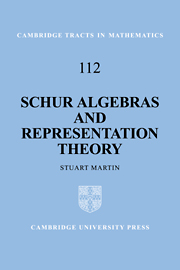Book contents
- Front matter
- Contents
- Introduction
- 1 Polynomial functions and combinatorics
- 2 The Schur algebra
- 3 Representation theory of the Schur algebra
- 4 Schur functors and the symmetric group
- 5 Block theory
- 6 The q-Schur algebra
- 7 Representation theory of Sq(n, r)
- Appendix: a review of algebraic groups
- References
- Index of Notation
- Index of Terms
7 - Representation theory of Sq(n, r)
Published online by Cambridge University Press: 22 September 2009
- Front matter
- Contents
- Introduction
- 1 Polynomial functions and combinatorics
- 2 The Schur algebra
- 3 Representation theory of the Schur algebra
- 4 Schur functors and the symmetric group
- 5 Block theory
- 6 The q-Schur algebra
- 7 Representation theory of Sq(n, r)
- Appendix: a review of algebraic groups
- References
- Index of Notation
- Index of Terms
Summary
One task remaining from the previous chapter is to obtain a complete list of irreducible Sq(n, r)-modules, thus completing the job begun for characteristic zero in 6.5.3. Unfortunately the situation for finite characteristic is more problematic: whichever approach is adopted there seems to be no quick way of showing that the irreducible Sq(n, r)-modules are indexed by Λ+(n, r). One approach would be to bring out the quantum GLn and use quantum group theory, a method employed by Parshall and Wang [1991, §8]. The Dipper and James [1991] approach is to define a certain q-analogue of the Weyl module. Over K the similarity with the classical case is striking: the q-Weyl module Vq(λ) has a unique maximal submodule and therefore a simple top factor Fq(λ). They show that, as λ runs through the dominant weights, the Fq(λ) will then give a complete set of simple Sq(n,r)-modules. The analogy with the situation studied in previous chapters (referred to henceforth as the ‘classical case’) is a persuasive one: for example in 7.5 we show that Sq(n,r) is quasi-hereditary having as standard modules the q-Weyl modules.
Returning to the q-universe constructed in Chapter 6, we already have at our disposal several q-analogues of structures in the classical situation. We have, for example, a qanalogue of the polynomial coalgebra, namely Aq(n, r), and of the Schur algebra, namely Sq(n, r), but as yet there is nothing even remotely resembling a q-version of GLn.
Information
- Type
- Chapter
- Information
- Schur Algebras and Representation Theory , pp. 185 - 211Publisher: Cambridge University PressPrint publication year: 1994
